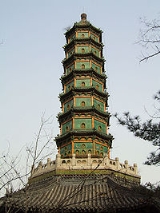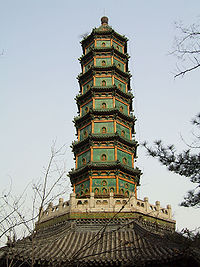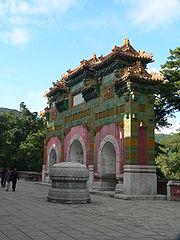
Fragrant Hills
Encyclopedia

Western Hills
The Western Hills refers to the hills and mountains in the western part of Beijing.- Geography :Being an extension of the Taihang mountain range from Hebei Province, the Western Hills cover about 17% of Beijing municipality including most of Mentougou and Fangshan Districts as well as parts of...
in the Haidian District, in the northwestern part of Beijing
Beijing
Beijing , also known as Peking , is the capital of the People's Republic of China and one of the most populous cities in the world, with a population of 19,612,368 as of 2010. The city is the country's political, cultural, and educational center, and home to the headquarters for most of China's...
, China. It covers 1.6 km² (395 acres) and consists of a natural pine-cypress forest
Pine-cypress forest
Pine-cypress forest is a type of mixed conifer woodland in which at least one species of pine and one species of cypress are present. Such forests are noted in several parts of North America including Florida and California.-California occurrences:...
, hills with maple trees, smoke tree
Smoke tree
Smoketree or Smoke bush is a genus of two species of flowering plants in the family Anacardiaceae, closely related to the sumacs .-Characteristics:...
s and persimmon trees
Persimmon
A persimmon is the edible fruit of a number of species of trees in the genus Diospyros in the ebony wood family . The word Diospyros means "the fire of Zeus" in ancient Greek. As a tree, it is a perennial plant...
, as well as landscaped areas with traditional architecture and cultural relics. The name derives from the park's highest peak, Xianglu Feng (Incense Burner Peak), a 557 meters (1827 ft) hill with two large stones resembling incense burners at the top.
Name



History
The park was built in 1186 in the Jin Dynasty (1115 to 1234) and expanded during the Yuan DynastyYuan Dynasty
The Yuan Dynasty , or Great Yuan Empire was a ruling dynasty founded by the Mongol leader Kublai Khan, who ruled most of present-day China, all of modern Mongolia and its surrounding areas, lasting officially from 1271 to 1368. It is considered both as a division of the Mongol Empire and as an...
and Ming Dynasty
Ming Dynasty
The Ming Dynasty, also Empire of the Great Ming, was the ruling dynasty of China from 1368 to 1644, following the collapse of the Mongol-led Yuan Dynasty. The Ming, "one of the greatest eras of orderly government and social stability in human history", was the last dynasty in China ruled by ethnic...
. In 1745, Emperor Qianlong (1711 to 1799) ordered the addition of many new halls, pavilions and gardens and gave it a new name, Jingyi Garden (Garden of Tranquility and Pleasure). Many of the relics in the park were damaged by foreign troops during two major attacks. In 1860, British troops set the Old Summer Palace
Old Summer Palace
The Old Summer Palace, known in China as Yuan Ming Yuan , and originally called the Imperial Gardens, was a complex of palaces and gardens in Beijing...
ablaze, burning it to the ground along with the Gardens of Perfect Brightness, causing extensive damage to many relics in the park. Another attack in 1900 by the Eight-Nation Alliance
Eight-Nation Alliance
The Eight-Nation Alliance was an alliance of Austria-Hungary, France, Germany, Italy, Japan, Russia, the United Kingdom, and the United States whose military forces intervened in China to suppress the anti-foreign Boxers and relieve the siege of the diplomatic legations in Beijing .- Events :The...
caused destruction to the park and to the Summer Palace
Summer Palace
The Summer Palace is a palace in Beijing, China. The Summer Palace is mainly dominated by Longevity Hill and the Kunming Lake. It covers an expanse of 2.9 square kilometers, three quarters of which is water....
built by Empress dowager Cixi
Cixi
Cixi may refer to:*Empress Dowager Cixi , empress of the Qing Dynasty*Cixi City, in Ningbo, Zhejiang, China...
. Since 1949, the Chinese government has been engaged in continuous restoration and development in the area.
Fragrant Hills Park is recognized as one of the major tourist attractions in Beijing. When autumn arrives, the natural scenery in the park turns spectacular, with fiery red smoke tree leaves covering the mountain side. Every year, thousands of tourists ride the cable cars through the park in order see the hills in autumn colors. The grand opening of the annual Red Leaf Festival of Beijing takes place there.
There is also the Fragrant Hill Hotel, designed by I. M. Pei
I. M. Pei
Ieoh Ming Pei , commonly known as I. M. Pei, is a Chinese American architect, often called a master of modern architecture. Born in Canton, China and raised in Hong Kong and Shanghai, Pei drew inspiration at an early age from the gardens at Suzhou...
, which is more traditional than most of his designs.
Routes
There are two main routes through the park. One route goes through the north area, with Spectacles Lake (Yanjing Lake) and the bridge, Study of Reading Heart (Jianxin Zhai) and Bright Temple (Zhao Miao). Study of Reading Heart was built in the Ming Dynasty (1368 to 1644) and is a landscaped park inside Fragrant Hills Park. Bright Temple is a large Tibetan style lamasery complex built in 1780 as the residence for the sixth Panchen LamaPanchen Lama
The Panchen Lama , or Bainqên Erdê'ni , is the highest ranking Lama after the Dalai Lama in the Gelugpa lineage of Tibetan Buddhism...
during his visits to Emperor Qianlong. Buildings in the complex have partially been burned down. Among the surviving treasures are a majestic glazed-tiled archway in front of the complex, a terrace and a glazed-tiled pagoda. Bells hung on the eaves of the pagoda chime in breeze.
The second route leads through the south area of the park. Main attractions along the route include Tranquility Green Lake (Jingcui Lake), Shuangqing Villa, Fragrant Temple, and Incense Burner Peak. This route is more difficult because it leads across the highest peak, Incense Burner Peak.
Another point of interest in the park is the Shuangqing Villa, once the residence of Mao Zedong
Mao Zedong
Mao Zedong, also transliterated as Mao Tse-tung , and commonly referred to as Chairman Mao , was a Chinese Communist revolutionary, guerrilla warfare strategist, Marxist political philosopher, and leader of the Chinese Revolution...
and also an early site for the headquarters of the Central Committee of the Communist Party of China
Communist Party of China
The Communist Party of China , also known as the Chinese Communist Party , is the founding and ruling political party of the People's Republic of China...
.
The Temple of Azure Clouds
Temple of Azure Clouds
The Temple of Azure Clouds , is a Buddhist temple located in the eastern part of the Western Hills, just outside the north gate of Fragrant Hills Park , in the Haidian District, a northwestern suburb of Beijing, China, approximately 20 km from the city center...
(Biyun Si) is located just outside the north gate of Fragrant Hills Park.
External links
- Beijing Xiangshan Park. Official site of Beijing Xiangshan Park.
- Fragrant Hills Park. Official site of the Beijing 2008 Olympic Games.
39°59′27.59"N 116°10′46.89"E

